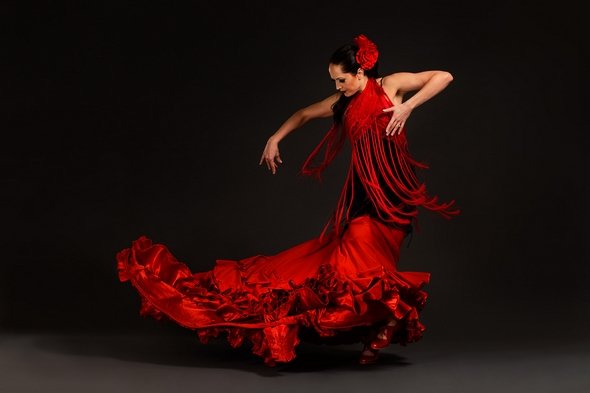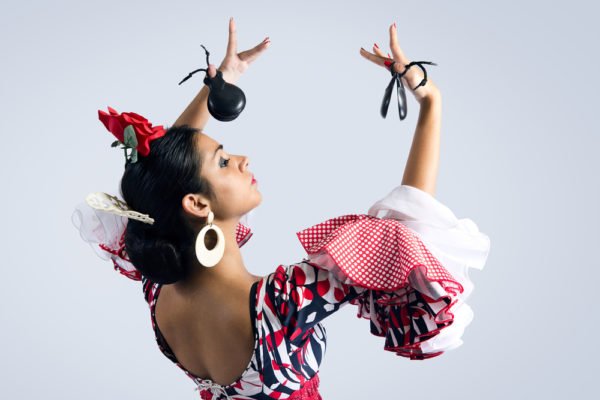WORLD MUSIC TRADITIONS - SPAIN, the Heart of Flamenco!


Flamenco

Handclapping (palmas) as well as finger-snapping (palillos or pitos) are common in traditional flamenco performance. These gestures articulate the basic beat, though frequently the onlookers interlock their claps to create a thick rhythmic density that heightens the tension of the music. The dancers also add a rhythmic vibrancy through their toe- and heel- stamping choreography and/or use of castanets, a wooden clapper held in each hand.
Flamenco music generally emphasizes minor keys, and triple meters are more common. Many flamenco performances shift the meter from triple to duple and back to triple frequently within a single song. Rhythmically free passages may be interspersed within a performance.
Improvisation is a key element of flamenco, on the part of the guitarist, vocalist, and dancers. While the vocalist generally leads a performance, any of these three elements— voice, guitar, or dance—can change the mood of a performance through shifts in meter, tempo, dynamics, or rhythmic complexity.
known as Paco de Lucía, famous Spanish guitarist and compositor.
Flamenco was born in Andalusia, the southern region of Spain. Originally, flamenco featured the voice alone, in a song form known as cante. This traditional Spanish style of singing incorporates the strained timbre and heavy use of melisma typical of Arabic vocal traditions, reflecting the more than seven hundred years of Arabic influence in the region. Arabic influence is also reflected in the style’s generally vibrant rhythmic activity. Cante is typically divided into three forms—deep, intermediate, and light—determined by the subject matter and rhythmic structure. Cante performances frequently feature audience participation in the form of handclapping, dance, and vocal interjections.
While modern flamenco is frequently performed on a concert stage, traditional contexts for flamenco are much more intimate. The ideal setting is a juerga, an informal event in which the separation between musicians and audience is blurred. Everyone participates, if only with clapping and shouts of encouragement known as jaleo. These gatherings can hap- pen almost anywhere, on a side street, in a tapas bar, at a musician’s home, and so on. They usually last late into the night, often until dawn, and are characterized by much laughter and a family feeling.
Flamenco has continued to develop in new ways. Theatrical productions of flamenco dance and song are common, and flamenco troupes are frequently found on international tours. Since the 1960s some artists have fused flamenco with other music forms, such as jazz and rock, to create popular sounds with a global appeal. Artists such as Paco de Lucía and the Gipsy Kings have helped to widen the audience of flamenco through their innovative compositions, while remaining true to the roots of the music and the spirit of duende.

🎶🎵Sharing my music all around the world! 🎵🎶
Spotify
Facebook
Steemit
Instagram
Congratulations @nadabrahmasounds! You have completed the following achievement on the Steem blockchain and have been rewarded with new badge(s) :
Click on the badge to view your Board of Honor.
If you no longer want to receive notifications, reply to this comment with the word
STOPYour post had been curated by the @buildawhale team and mentioned here:
https://steemit.com/curation/@buildawhale/buildawhale-curation-digest-09-24-18
Keep up the good work and original content, everyone appreciates it!